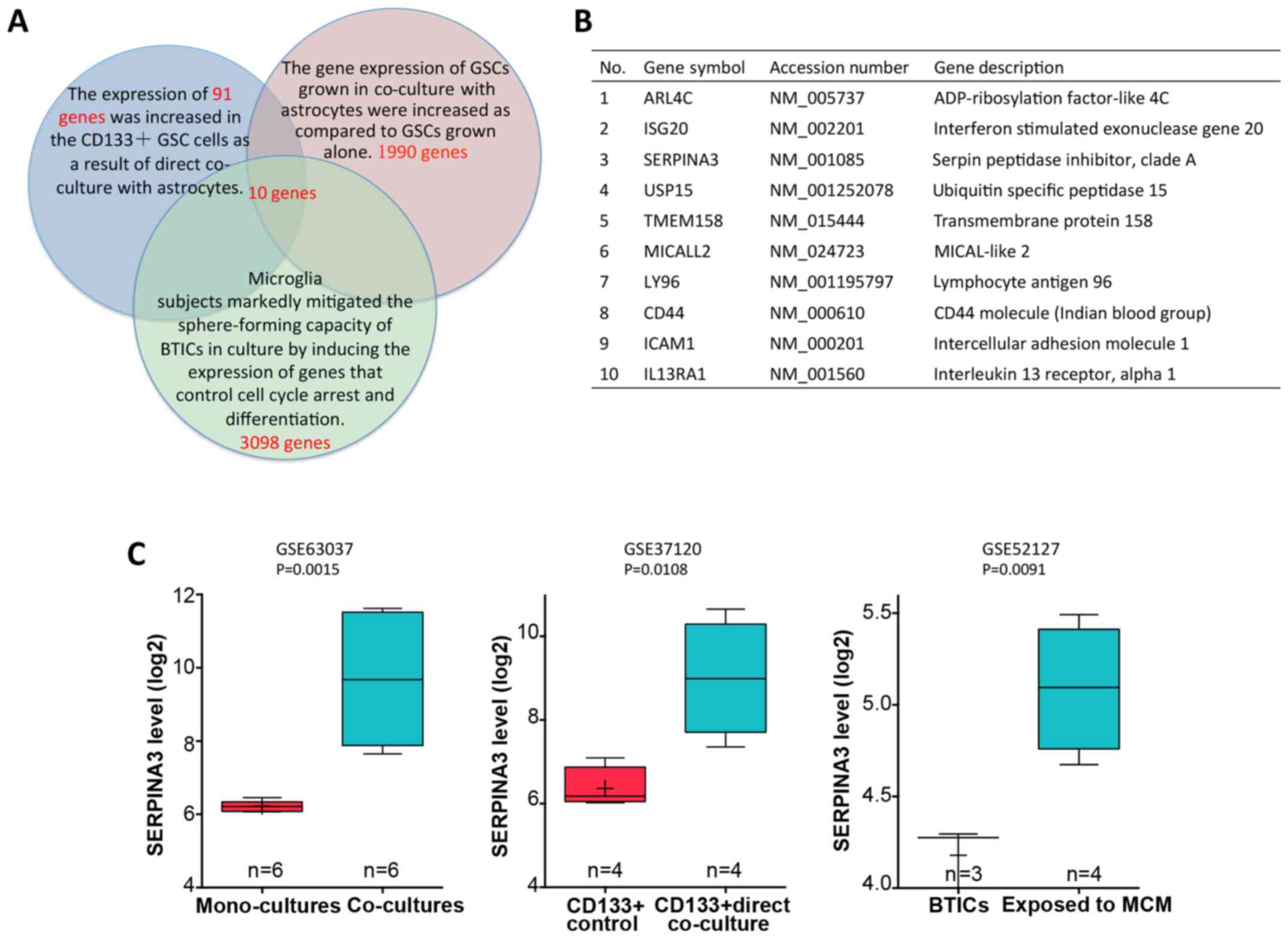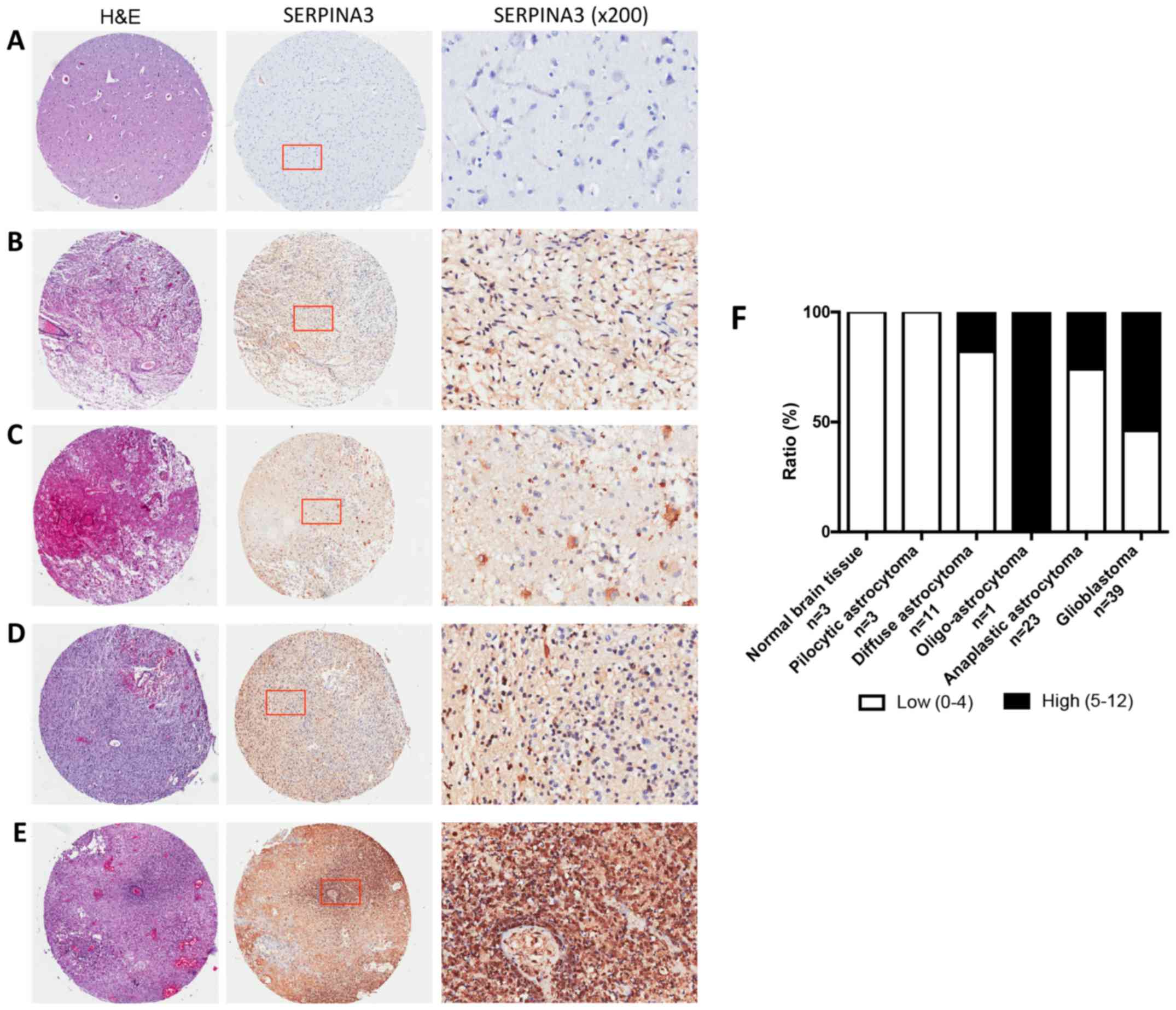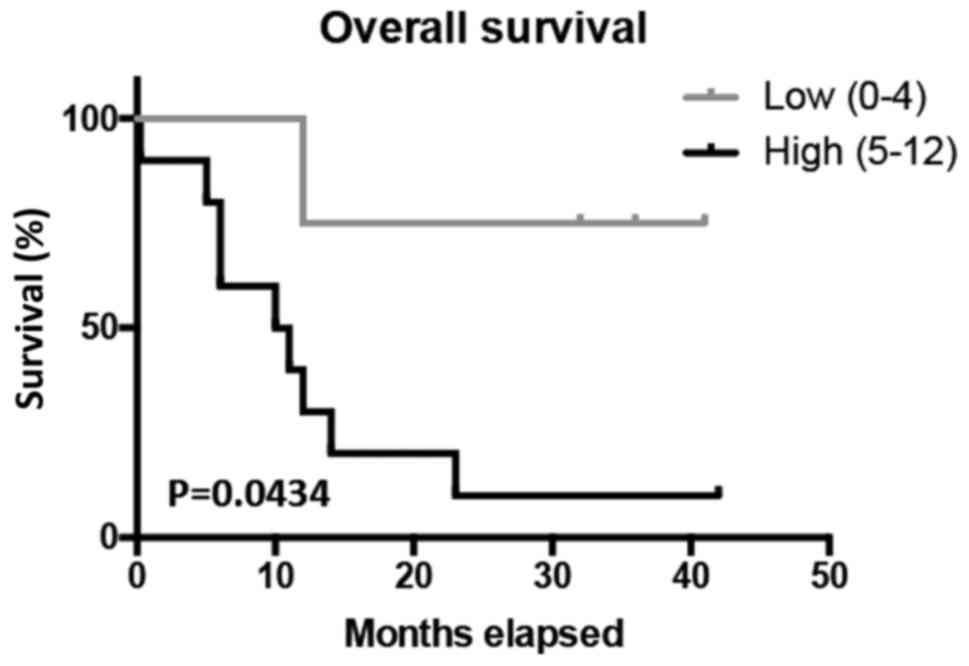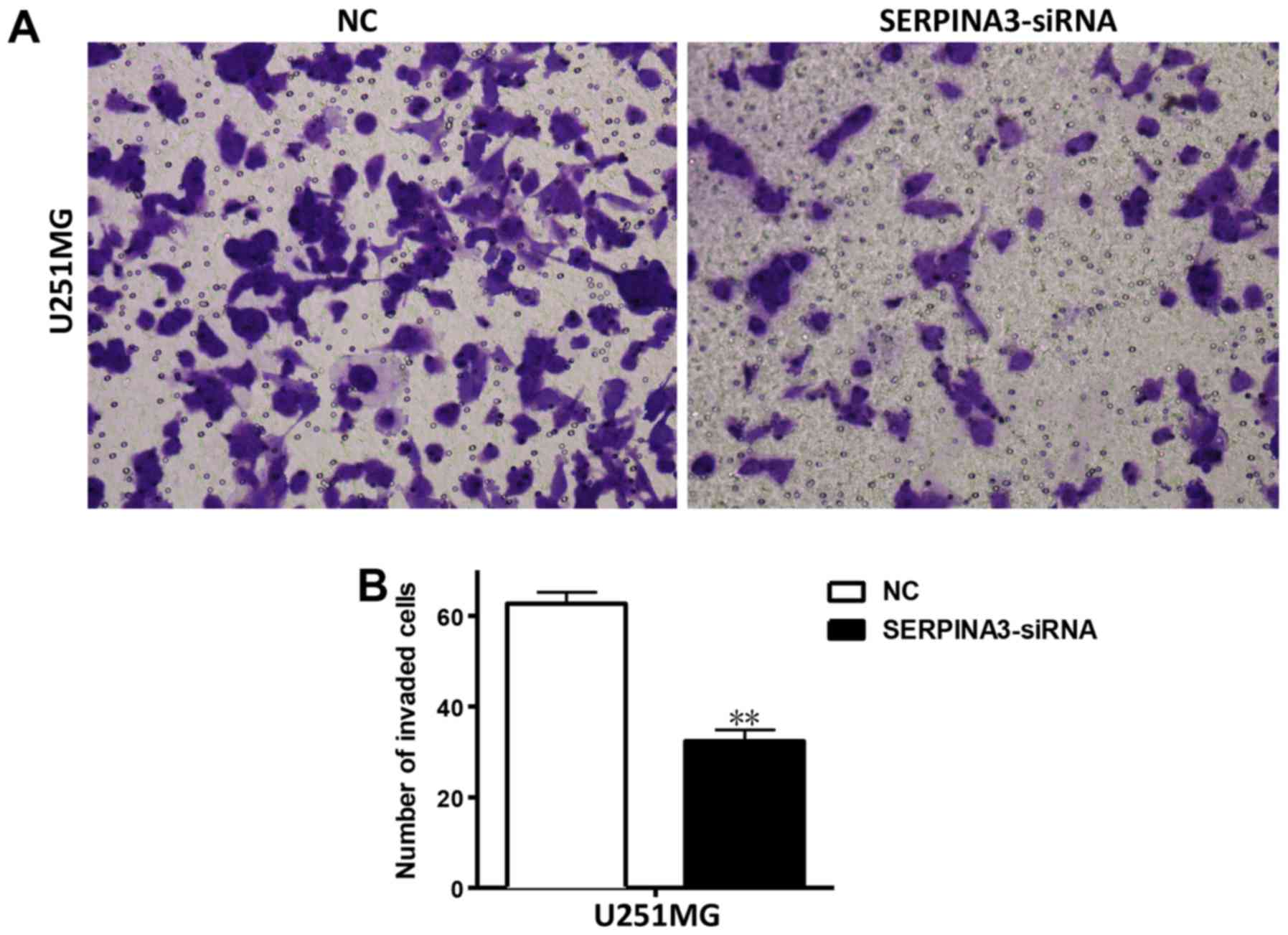|
1
|
Meyer MA: Malignant gliomas in adults. N
Engl J Med. 359:18502008. View Article : Google Scholar : PubMed/NCBI
|
|
2
|
Chen D, Song M, Mohamad O and Yu SP:
Inhibition of Na+/K+-ATPase induces hybrid cell death and enhanced
sensitivity to chemotherapy in human glioblastoma cells. BMC
Cancer. 14:7162014. View Article : Google Scholar : PubMed/NCBI
|
|
3
|
Binda E, Visioli A, Giani F, Trivieri N,
Palumbo O, Restelli S, Dezi F, Mazza T, Fusilli C, Legnani F, et
al: Wnt5a drives an invasive phenotype in human glioblastoma
stem-like cells. Cancer Res. 77:996–1007. 2017. View Article : Google Scholar : PubMed/NCBI
|
|
4
|
Bao S, Wu Q, McLendon RE, Hao Y, Shi Q,
Hjelmeland AB, Dewhirst MW, Bigner DD and Rich JN: Glioma stem
cells promote radioresistance by preferential activation of the DNA
damage response. Nature. 444:756–760. 2006. View Article : Google Scholar : PubMed/NCBI
|
|
5
|
Eramo A, Ricci-Vitiani L, Zeuner A,
Pallini R, Lotti F, Sette G, Pilozzi E, Larocca LM, Peschle C and
De Maria R: Chemotherapy resistance of glioblastoma stem cells.
Cell Death Differ. 13:1238–1241. 2006. View Article : Google Scholar : PubMed/NCBI
|
|
6
|
Rath BH, Fair JM, Jamal M, Camphausen K
and Tofilon PJ: Astrocytes enhance the invasion potential of
glioblastoma stem-like cells. PLoS One. 8:e547522013. View Article : Google Scholar : PubMed/NCBI
|
|
7
|
Hanahan D and Weinberg RA: Hallmarks of
cancer: The next generation. Cell. 144:646–674. 2011. View Article : Google Scholar : PubMed/NCBI
|
|
8
|
Rath BH, Wahba A, Camphausen K and Tofilon
PJ: Coculture with astrocytes reduces the radiosensitivity of
glioblastoma stem-like cells and identifies additional targets for
radiosensitization. Cancer Med. 4:1705–1716. 2015. View Article : Google Scholar : PubMed/NCBI
|
|
9
|
Kalsheker NA: Alpha 1-antichymotrypsin.
Int J Biochem Cell Biol. 28:961–964. 1996. View Article : Google Scholar : PubMed/NCBI
|
|
10
|
Baker C, Belbin O, Kalsheker N and Morgan
K: SERPINA3 (aka alpha-1-antichymotrypsin). Front Biosci.
12:2821–2835. 2007. View
Article : Google Scholar : PubMed/NCBI
|
|
11
|
Sun YX, Wright HT and Janciauskiene S:
Glioma cell activation by Alzheimer's peptide Abeta1-42,
alpha1-antichymotrypsin, and their mixture. Cell Mol Life Sci.
59:1734–1743. 2002. View Article : Google Scholar : PubMed/NCBI
|
|
12
|
Bodmer JL and Schnebli HP: Plasma
proteinase inhibitors. Schweiz Med Wochenschr. 114:1359–1363.
1984.PubMed/NCBI
|
|
13
|
Sun YX, Wright HT and Janciauskiene S:
Alpha1-antichymotrypsin/Alzheimer's peptide Abeta(1–42) complex
perturbs lipid metabolism and activates transcription factors
PPARgamma and NFkappaB in human neuroblastoma (Kelly) cells. J
Neurosci Res. 67:511–522. 2002. View Article : Google Scholar : PubMed/NCBI
|
|
14
|
Karashima S, Kataoka H, Itoh H, Maruyama R
and Koono M: Prognostic significance of alpha-1-antitrypsin in
early stage of colorectal carcinomas. Int J Cancer. 45:244–250.
1990. View Article : Google Scholar : PubMed/NCBI
|
|
15
|
Hurlimann J and van Melle G: Prognostic
value of serum proteins synthesized by breast carcinoma cells. Am J
Clin Pathol. 95:835–843. 1991. View Article : Google Scholar : PubMed/NCBI
|
|
16
|
Lein M, Stephan C, Jung K, Schnorr D and
Loening SA: Molecular forms of prostate-specific antigen and human
kallikrein 2 as possible indicators in prostatic carcinoma
diagnosis. Urologe A. 39:313–323. 2000.(In German). View Article : Google Scholar : PubMed/NCBI
|
|
17
|
Higashiyama M, Doi O, Yokouchi H, Kodama
K, Nakamori S and Tateishi R: Alpha-1-antichymotrypsin expression
in lung adenocarcinoma and its possible association with tumor
progression. Cancer. 76:1368–1376. 1995. View Article : Google Scholar : PubMed/NCBI
|
|
18
|
Zelvyte I, Wallmark A, Piitulainen E,
Westin U and Janciauskiene S: Increased plasma levels of serine
proteinase inhibitors in lung cancer patients. Anticancer Res.
24:241–247. 2004.PubMed/NCBI
|
|
19
|
Tahara E, Ito H, Taniyama K, Yokozaki H
and Hata J: Alpha 1-antitrypsin, alpha 1-antichymotrypsin, and
alpha 2-macroglobulin in human gastric carcinomas: A retrospective
immunohistochemical study. Hum Pathol. 15:957–964. 1984. View Article : Google Scholar : PubMed/NCBI
|
|
20
|
Zhou SM, Cheng L, Guo SJ, Wang Y,
Czajkowsky DM, Gao H, Hu XF and Tao SC: Lectin RCA-I specifically
binds to metastasis-associated cell surface glycans in
triple-negative breast cancer. Breast Cancer Res. 17:362015.
View Article : Google Scholar : PubMed/NCBI
|
|
21
|
Sjoestroem C, Khosravi S, Cheng Y, Safaee
Ardekani G, Martinka M and Li G: DLC1 expression is reduced in
human cutaneous melanoma and correlates with patient survival. Mod
Pathol. 27:1203–1211. 2014. View Article : Google Scholar : PubMed/NCBI
|
|
22
|
Remmele W and Stegner HE: Recommendation
for uniform definition of an immunoreactive score (IRS) for
immunohistochemical estrogen receptor detection (ER-ICA) in breast
cancer tissue. Pathologe. 8:138–140. 1987.(In German). PubMed/NCBI
|
|
23
|
Abd Hamid UM, Royle L, Saldova R,
Radcliffe CM, Harvey DJ, Storr SJ, Pardo M, Antrobus R, Chapman CJ,
Zitzmann N, et al: A strategy to reveal potential glycan markers
from serum glycoproteins associated with breast cancer progression.
Glycobiology. 18:1105–1118. 2008. View Article : Google Scholar : PubMed/NCBI
|
|
24
|
Friedl P and Alexander S: Cancer invasion
and the microenvironment: Plasticity and reciprocity. Cell.
147:992–1009. 2011. View Article : Google Scholar : PubMed/NCBI
|
|
25
|
The tumor microenvironment mediates GBM
resistance to CSF1R blockade. Cancer Discov. 6:6902016. View Article : Google Scholar
|
|
26
|
Sarkar S, Döring A, Zemp FJ, Silva C, Lun
X, Wang X, Kelly J, Hader W, Hamilton M, Mercier P, et al:
Therapeutic activation of macrophages and microglia to suppress
brain tumor-initiating cells. Nat Neurosci. 17:46–55. 2014.
View Article : Google Scholar : PubMed/NCBI
|
|
27
|
Sofroniew MV and Vinters HV: Astrocytes:
Biology and pathology. Acta Neuropathol. 119:7–35. 2010. View Article : Google Scholar : PubMed/NCBI
|
|
28
|
Charles NA, Holland EC, Gilbertson R,
Glass R and Kettenmann H: The brain tumor microenvironment. Glia.
60:502–514. 2012. View Article : Google Scholar : PubMed/NCBI
|
|
29
|
Danø K, Andreasen PA, Grøndahl-Hansen J,
Kristensen P, Nielsen LS and Skriver L: Plasminogen activators,
tissue degradation, and cancer. Adv Cancer Res. 44:139–266. 1985.
View Article : Google Scholar : PubMed/NCBI
|
|
30
|
Mignatti P and Rifkin DB: Biology and
biochemistry of proteinases in tumor invasion. Physiol Rev.
73:161–195. 1993.PubMed/NCBI
|
|
31
|
Dodwell DJ: Proteinase inhibitors in
malignancy: Therapeutic promise or another white elephant? J R Soc
Med. 86:573–576. 1993.PubMed/NCBI
|
|
32
|
Liotta LA and Kohn EC: The
microenvironment of the tumour-host interface. Nature. 411:375–379.
2001. View
Article : Google Scholar : PubMed/NCBI
|
|
33
|
Beatty K, Bieth J and Travis J: Kinetics
of association of serine proteinases with native and oxidized
alpha-1-proteinase inhibitor and alpha-1-antichymotrypsin. J Biol
Chem. 255:3931–3934. 1980.PubMed/NCBI
|


















